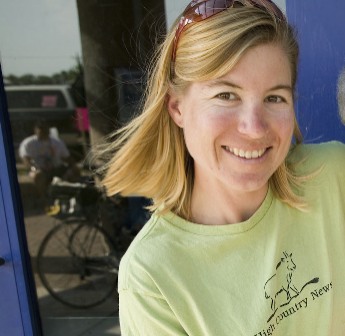
Christie Aschwanden shows that when it comes to selling evidence-based health care reforms, hammering people with the facts won’t change entrenched beliefs—in fact, it may only strengthen them. For evidence-based reforms to succeed, Aschwanden writes, they must put in place a narrative that patients, doctors, and health policy makers can accept and even embrace. “Convincing the Public to Accept New Medical Guidelines” appeared in Miller-McCune on April 20, 2010.
Here, Aschwanden tells TON co-founder Siri Carpenter the story behind the story. (This interview has been edited for length and clarity.)
Why did you want to do this story?
I’ve always been fascinated by how people decide what to believe and how beliefs shape our perception of the world. That theme has turned up again and again in stories that I’ve written for other magazines, ranging from Bicycling magazine to High Country News. One of the reasons I was interested in writing this story, for a broader audience, was that there’s a huge interest right now in doing evidence-based medicine, and there was a lot of money in the stimulus package to fund comparative effectiveness research. I felt that my story could serve as a warning about potential challenges in implementing evidence-based medicine.
Given how broadly that idea applies, why did you choose the particular examples that you did: ibuprofen use among long-distance runners, mammograms, and back pain?
I had a lot of examples in my original pitch, but in writing the story, deciding which examples to use was about figuring out how I thought people might approach the piece. I was worried about the mammogram issue because it was so controversial, and many, many people already have very strong opinions there. That’s why I led with the ibuprofen example—out of those three, it represented something where people might be a little more rational about the issue. Then I used the mammogram controversy because it was something that flared up while I was working on the piece. And I used the back pain example because it’s been studied so much, so there’s a lot of data.
How did you decide where to pitch the story?
I first pitched The New York Times Magazine in September of 2008, with a recommendation from another editor there, but I never even got a response. Then I pitched it to Mother Jones and got an editor there really interested, but in the end, the higher-ups thought it was maybe just a little too wonky. At that point, it really just kind of sat there. I was feeling a little demoralized, and I was busy doing a lot of different stuff, so I kind of dropped it.
What made you pick it up again?
In the summer of 2009, I was at the Aspen Health Forum working on a story for the Los Angeles Times, and I was really taken aback by some comments by the then-CEO of the Susan G. Komen Foundation, regarding the new study that had found that mammography was turning healthy women into cancer patients, and that over-diagnosis was a significant problem. This CEO told me straight out that this problem doesn’t exist. I thought, “Wow, this is huge. This is complete denial. This isn’t just a matter of people who are not versed in science not believing what their doctor tells them. This is big decision-makers, people who are influencing how people think about these things.” That re-energized me. So I kept thinking about it, and I pitched it to a couple of women’s magazines, with the mammogram angle. I think people didn’t want to touch it, at least in the way I wanted to write about it. I think they wanted stories reassuring women that it’s OK to ignore these findings.
Were you tempted to drop the idea then?
I had a lot of encouragement from a friend, who kept telling me, “Don’t give up on it.” I knew [Miller-McCune editor] John Mecklin, and although I had never written a story for him, he had invited me to pitch him. I had started reading Miller-McCune and thought it was a terrific magazine and this was a great fit because they did a lot of insightful analyses of complex issues. So I sent him the pitch last November. I didn’t hear from him, so a little over a week later I got back to him and it turned out he hadn’t received it. When I resent it, he assigned it almost immediately.
Once you had the assignment, how did you approach the reporting?
I had reported on much of this material before, but I needed to go back and make sure I knew what the current state of affairs was, what the best studies were to show certain points. I contacted some researchers whom I had interviewed for other stories, to ask them: Has anything changed, is this still accurate, here’s my take, and is that right? A lot of those people weren’t quoted in the story—I probably interviewed close to twice as many people as made it into the story.
Another really good resource was a listserv for people who do research on evidence-based medicine, which I had joined a while back. That was helpful for getting some ideas, and then I actually posted a query on that, and got some good sources and papers.
I also spent several days doing literature searches, to make sure I knew what I was talking about. Most of that literature didn’t make it into the piece, but I wanted to make sure I had a handle on what the best research showed. I didn’t want to fall victim to the very phenomenon I was pointing out in my story.
This is a very conceptual story. How did you figure out how to structure it?

I did a lot of thinking when I was out running and stuff, and then I went to the big chalkboards that I use to map stuff out on. I wrote out all these ideas that I knew I wanted to include, then drew lines from one to another to figure out how to connect them.
What was challenging about the project?
It took me a little while to get that last, concluding part. The first three parts of the piece are all pretty much as I had written them in my pitch. But the last part, which pulls it all together, I just felt like something was off. But someone sent me a [Stephen] Colbert clip and I realized that this is a “truthiness” issue. I realized that the important point I wanted to make was that the ideas that are attractive are the ideas that will stick with us. There’s this huge incentive to believe in that fairy tale.
Is there anything you would do differently, if you could?
I felt really demoralized when I got completely ignored by The New York Times Magazine and turned down by Mother Jones. I feel like the lesson here was that I should have been more confident and kept pushing. I was too quick to drop it.
Another lesson was in matching the pitch to the publication. There’s something to be said for writing for some of these smaller publications where you really get to express your own voice. It was really nice to end up with something that really was mine. At some other magazines, it would have gone through a sausage factory. It’s an argument for the idea that having your pitch turned down doesn’t mean it’s a bad story—it just means you haven’t found the perfect home yet.
A glimpse behind the scenes:

Siri Carpenter is co-founder and editor-in-chief of The Open Notebook. Follow her on Twitter @SiriCarpenter.


